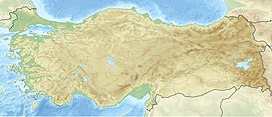| Mount Hasan | |
|---|---|
 View of Mount Hasan | |
| Highest point | |
| Elevation | 3,268 m (10,722 ft)[1] |
| Prominence | 1,922 m (6,306 ft)[1] |
| Listing | Ultra |
| Coordinates | 38°07′39″N 34°10′00″E / 38.12750°N 34.16667°E[1] |
| Geography | |
| Location | Aksaray Province, Turkey |
| Geology | |
| Mountain type | Stratovolcano |
| Last eruption | 6200 BC |
Mount Hasan (Turkish: Hasan Dağı) is a volcano in Anatolia, Turkey. It has two summits, the 3,069 metres (10,069 ft) high eastern Small Hasan Dagi and the 3,253 metres (10,673 ft) high Big Hasan Dagi, and rises about 1 kilometre (0.62 mi) above the surrounding terrain. It consists of various volcanic deposits, including several calderas, and its activity has been related to the presence of several faults in the area and to regional tectonics.
Activity began in the Miocene and continued into the Holocene; a mural found in the archeological site of Çatalhöyük has been controversially interpreted as showing a volcanic eruption or even a primitive map. It was the second mountain from the south in the Byzantine beacon system used to warn the Byzantine capital of Constantinople of incursions during the Arab–Byzantine wars.
- ^ a b c "Turkey: 23 Mountain Summits with Prominence of 1,500 meters or greater". Peaklist.org. Retrieved 2014-05-25.
